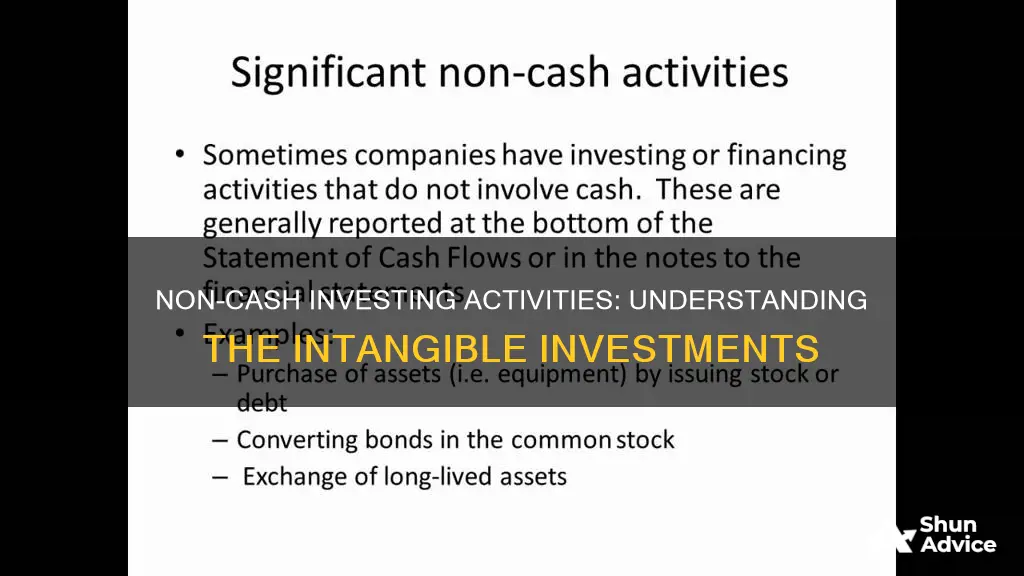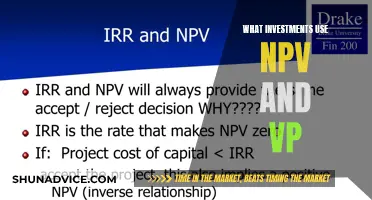
Non-cash investing activities are business transactions that do not involve the transfer of cash and, therefore, do not appear on a company's cash flow statement. However, these activities can still significantly impact a company's financial position and capital composition. Examples of non-cash investing activities include the issuance of common shares for dividend purposes, the conversion of bonds or preferred shares, and the exchange of non-monetary assets. These transactions are typically disclosed in a separate section of the cash flow statement or in supplementary information.
What You'll Learn

Converting debt to equity
Non-cash investing activities are those that do not generate any cash inflows or outflows but can still significantly impact a company's financial position and capital composition. They are disclosed in the supplementary information or footnotes of a company's cash flow statement.
During a debt-for-equity swap, a creditor's debt is converted into shares in the company, and the loan is no longer owed. This can be advantageous for the company as it eliminates interest payments on the debt and reduces the risk of enforcement by the lender. It also frees up cash, allowing the company to take on more borrowing and potentially improve its ability to borrow on more favourable terms.
However, the lender becomes a shareholder, which may be seen as a less secure position, particularly if the lender had security over the borrower's assets. For this reason, debt-for-equity swaps are often considered when a company is in financial difficulty and may not be able to repay its debts. The lender may agree to the swap if they believe there is a potential for greater financial upside as a shareholder, or if they will gain a controlling shareholding in the company.
The swap ratio between debt and equity can vary depending on the specific circumstances and negotiations. A higher ratio, such as 1:2, where the bondholder receives stocks valued at twice the amount of their bonds, may be offered to make the trade more enticing.
Debt-for-equity swaps can also provide tax advantages for both borrowers and lenders if carefully structured to avoid adverse tax consequences.
Smart Ways to Invest a Windfall of $150K Cash
You may want to see also

Acquiring assets by assuming related liabilities
Non-cash investing activities are those that do not generate any cash inflows or outflows but can still significantly affect a company's financial position and capital composition. They must be disclosed in a company's cash flow statement, either in a separate note or a supplementary schedule.
One example of a non-cash investing activity is "acquiring productive assets by assuming directly related liabilities". This means that a company purchases the assets of another company and, in doing so, takes on the related liabilities of those assets. This is an exception to the general rule that the buyer of a company's assets will not assume its debts and liabilities.
There are several factors that courts consider when determining whether a buyer has expressly or implicitly assumed the liabilities of a seller. Firstly, the language of the asset purchase agreement is crucial. If the agreement explicitly negates the assumption of liabilities, courts are unlikely to find an implied assumption. However, if the agreement contains ambiguous or broad language, such as stating that the buyer is purchasing the entire business, the buyer may be found to have implicitly assumed liabilities.
Another factor is the structure of the transaction. If the asset purchase is deemed a de facto merger, with continuity of business operations, directors, staff, and location, the buyer may be held responsible for the seller's liabilities. Additionally, if the buyer is considered a mere continuation of the seller's enterprise, with a common identity of officers, directors, and/or shareholders, they may also be found liable.
To minimise the risk of assuming unintended liabilities, buyers should conduct extensive due diligence, purchase assets through a newly created subsidiary, and carefully draft asset purchase agreements to specify exactly which liabilities are being assumed.
Physical Cash Investment: Strategies for Smart Money Allocation
You may want to see also

Issuing stock for no cash payment
Non-cash investing activities are transactions that do not generate any cash inflows or outflows but can still significantly impact a company's financial position and capital composition. One example of a non-cash investing activity is issuing stock for no cash payment.
For example, a company might issue 10,000 shares of $20 par common stock for a piece of land with a fair market value of $20 per share. In this case, the journal entry would show the value of the land as (10,000 x $20) and the stock issued at par value as (10,000 x $20). If the fair market value of the stock is higher than the par value, the company would also record a premium on the common stock issued. For instance, if the fair market value of the stock is $25 per share, the journal entry would include a premium on the common stock issued of (10,000 x $5).
Overall, issuing stock for no cash payment is a non-cash investing activity that can have important implications for a company's financial position and capital structure. It provides a way for companies to acquire assets or services without directly impacting their cash flow.
Smart Ways to Invest Your Cash Wisely
You may want to see also

Non-monetary asset exchange
Non-cash investing activities are those that do not generate any cash inflows or outflows but can still significantly impact a company's financial position and capital composition. They are not reported on the cash flow statement but must be disclosed in a separate note or supplementary schedule.
The accounting procedure for a non-monetary asset exchange is based on the fair values of the assets involved in the transaction. If the fair value of the asset received is more than the fair value of the asset given up, the difference is recorded as a gain. Conversely, if the fair value of the asset given up is more than the fair value of the asset received, the difference is recorded as a loss. In cases where the fair values of the assets cannot be determined, the recorded cost of the non-monetary asset acquired is based on the recorded amount of the asset that was surrendered.
Understanding Cash Equivalents: A Guide to Investing Wisely
You may want to see also

Depreciation and amortization
Non-cash investing activities are business activities that do not generate any cash inflows or outflows but can still significantly affect a company's financial position and capital composition. They are not reported on the cash flow statement but must be disclosed in the footnotes or supplementary schedules. Examples include the issuance of common shares for dividend purposes, the conversion of convertible bonds or preferred shares, and the exchange of non-monetary assets.
Depreciation
Depreciation is used for physical, tangible assets that are subject to having their costs allocated over their useful lives. It reflects that an asset is no longer worth its previous carrying cost. It is calculated by subtracting the asset's salvage or resale value from its original cost, and this difference is then depreciated evenly over the years of its expected life. The depreciated amount is recorded as an expense each year and serves as a tax deduction for the company.
There are several methods for calculating depreciation, including:
- Straight-line method: Depreciating the asset equally over its useful life.
- Declining balance method: Depreciating an accelerated amount earlier in the asset's life by multiplying the current book value by a fixed depreciation rate.
- Double-declining balance method: Similar to the declining balance method but with the rate doubled.
- Sum-of-the-years-digits method: Depreciating a proportion of costs based on the corresponding digit of the asset's useful life.
- Units of production: Assessing a baseline of anticipated usage and determining actual usage each year to calculate the proportion to depreciate.
Amortization
Amortization is used for intangible assets, such as patents, trademarks, copyrights, and franchise agreements. It involves spreading the cost of an intangible asset evenly over its useful life. Intangible assets typically don't have any resale or salvage value, and the same amount is expensed in each period.
The straight-line method is the most common method for amortization, and it is generally the only method used.
Differences
While depreciation and amortization are similar concepts, they differ in the types of assets they apply to and the methods allowed for their calculation. Depreciation is used for tangible assets, while amortization is for intangible assets. Depreciation often allows for accelerated methods, whereas amortization typically does not.
Additionally, depreciation incorporates the salvage value of an asset when determining the depreciable base, while amortization does not. Depreciation entries post to a contra account, reducing the carrying value of capital assets, while amortization may go directly to the intangible asset account.
Both depreciation and amortization are non-cash transactions that are often disclosed in the footnotes of a company's statement of cash flows. They are essential for accurately reflecting the value and usage of assets and for tax deduction purposes.
Understanding Cash Flow from Sales of Investments
You may want to see also
Frequently asked questions
Non-cash investing activities are business activities that do not involve the transfer of cash and, therefore, do not appear on a company's cash flow statement.
Although non-cash investing activities do not generate cash inflows or outflows, they can still significantly affect a company's financial position and capital composition.
Non-cash investing activities are reported in a separate section at the bottom of the statement of cash flows, either in a separate note or a supplementary schedule.
Examples of non-cash investing activities include depreciation and amortization, as well as the exchange of one non-monetary asset for another.
Yes, non-cash investing activities can impact a company's balance sheet. For example, purchasing a new asset may not involve an immediate cash outflow, but it will be recorded as an asset on the balance sheet, with depreciation expenses recognised over the life of the asset.







